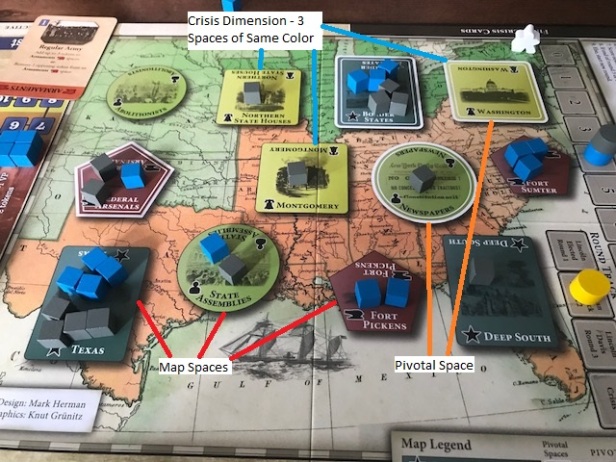Fort Sumter: The Secession Crisis, 1860-61 from GMT Games is a fast playing Card Driven Game that focuses on the events leading up to the eventual secession from the Union of the State of South Carolina on December 20, 1860 and the commencement of hostilities in the American Civil War as the CSA began the bombardment of Fort Sumter located in Charleston, South Carolina, on April 12-14, 1861. The game is not a wargame but a historically themed battle of the wills as players will use cards to place Political Capital Tokens in various colored spaces located on the map in order to gain control over those aspects of the crisis.
In this Action Point, we are going to take a look at the various spaces, including what is called a Crisis Dimension and Pivotal Spaces, and how players can manipulate those areas with cards for their gain.
The Map

First off, I want to give you a good understanding of the map used in the game. As you can see in the picture above, the map is made up of various similar colored spaces grouped throughout a map of the then United States of America stretching from Kansas and Texas in the west to the eastern seaboard and the original 13 colonies. The spaces that are similarly colored and grouped are called Crisis Dimensions and one space in the group is highlighted with a white border which is called a Pivotal Space. You will also see that the spaces have various colored cubes already in them and these are Political Capital Tokens that are placed through card play by players to gain control. None of these tokens start on the map at the beginning of the game.
There are four different Crisis Dimensions that represent various issues of importance to the debate at the time as to State’s Rights, Slavery, war and the politics of the fledgling United States of America. In each Crisis Dimension there are three spaces. The game is well done graphically, as not only are the spaces different colors, but they also contain a symbol that is affiliated with one of the four Dimensions. The four Dimensions are as follows: Armaments (red/cannon), Secession (blue/star), Political (yellow/bell) and Public Opinion (green/person). We will talk about these more in the next segment.
The 4 Crisis Dimensions
The central concept of the game is that of manipulating the various spaces on the map by playing Strategy cards, either for their event or for the number of Political Capital Tokens that can be placed. The number in the upper left hand corner of each card is what is referenced when playing a card for the Political Capital Tokens. The picture below shows three cards, two of which offer 2 Political Capital Tokens that can be placed in any space and one that offers 3. You will also notice that behind the numbers are colored boxes which are important in relation to the printed events on the cards. If the square matches your role, either that of the Unionist (blue) or the Secessionist (gray), rather than simply using the card for the points, you then are granted access to the printed event, which typically is more powerful than the numbers.

Each round, players will be dealt 4 cards. Only 3 of these cards will be used at this time, with one card being reserved for the Final Crisis round. After three rounds have passed, the players will have played 9 cards while reserving 3.

You will notice in the picture shown above that the Secessionist player has played the card Jefferson Davis. It has a Value of 2 and also has a grey box behind it which will allow the Secessionist to play for either the Value, by placing 2 tokens in any spaces, or for the event. In this example, the event is better and will be used to attempt to gain control of two of the Political spaces (the yellow ones) in order to score Victory Points. At the time the card is played, you will notice that in the Montgomery space that the Union has 2 cubes while the Secessionist has only one. This grants control of that space to the Union. So if you read the event, it says “Add up to 3 tokens to Political spaces…”. Knowing that the Secessionist nearly has control of the entire Crisis Dimension (as they have 1 Political Capital Token in the Northern State Houses space granting outright control of that space and are tied with the Union for control in Washington), the Secessionist decides to place 3 tokens in Political spaces rather than just do 2 generically in any spaces or even take the second part of the event to place tokens in Secession or Armaments spaces.

Notice the red lines extending out from the played event card, allowing the Secessionist player to place 2 tokens in Montgomery and 1 token in Washington. Both of these placements now grant control of the individual spaces to the Secessionist player and because they now control all three of the Political spaces, they control the Crisis Dimension and will score Victory Points at the end of the round, amongst other special abilities that we will talk about in a later Action Point post.
I hope that you enjoyed this look at the Crisis Dimensions and card play in Fort Sumter. In Action Point 2, we are going to take a look at the Crisis Track and some of the finer points of it for strategy.
-Grant
